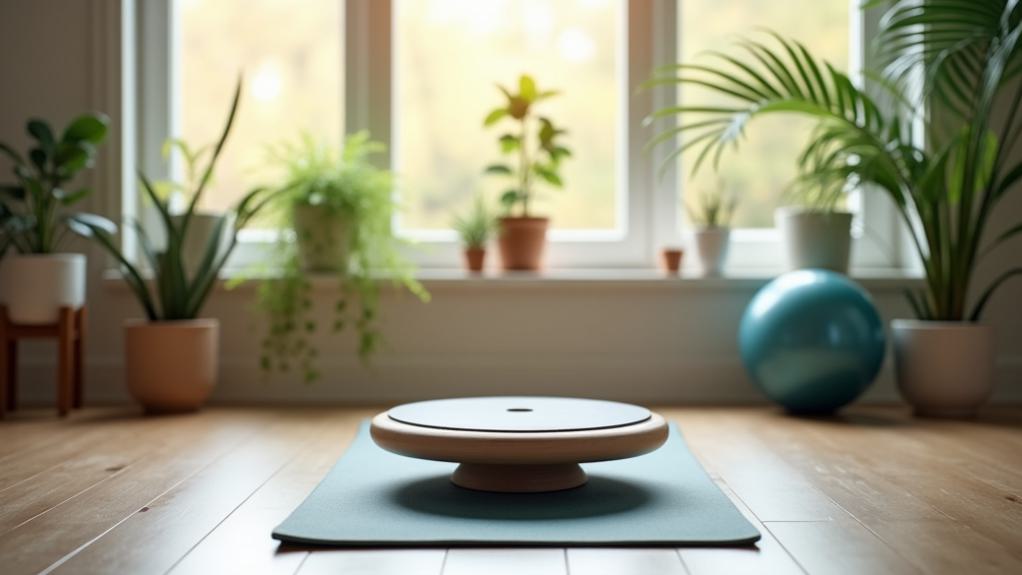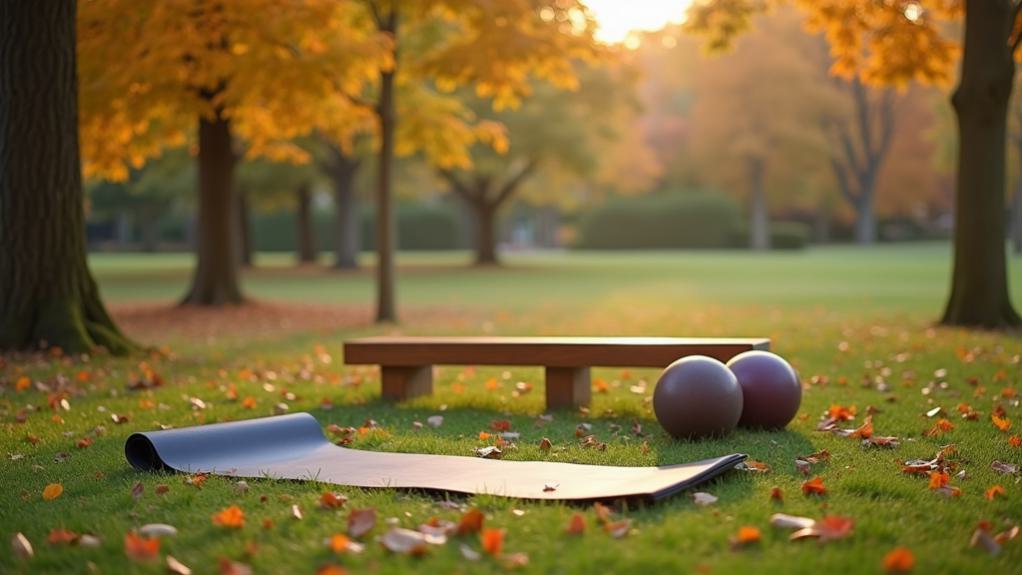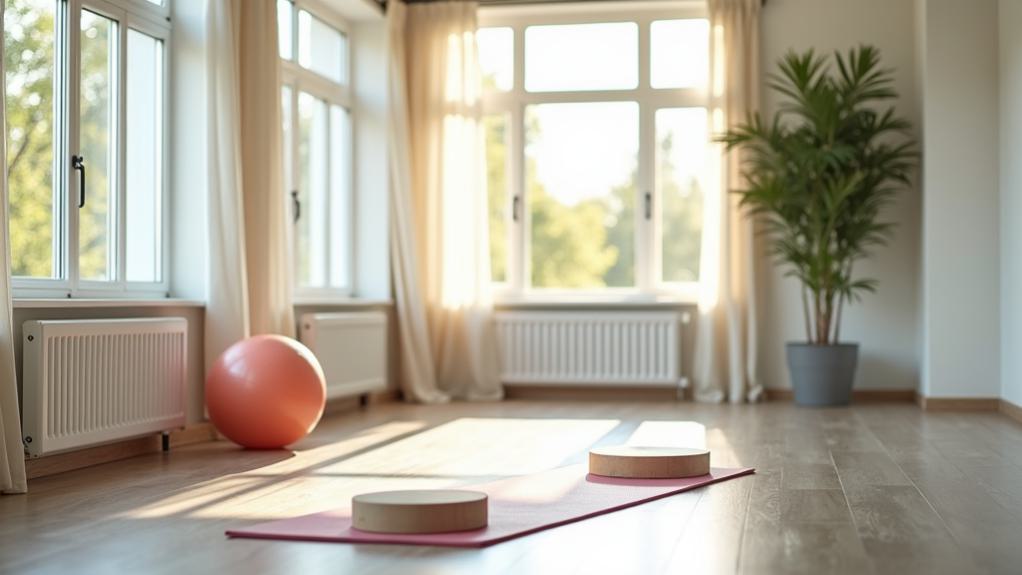To improve your balance and stability in midlife, start incorporating exercises like single-leg stands and Tai Chi into your routine. These activities enhance muscle control and proprioception, reducing fall risk.
Try heel-to-toe walks for coordination and lateral leg lifts with resistance bands to build strength. Practicing these exercises daily can make a noticeable difference in your stability and confidence.
Don’t forget to set achievable goals and track your progress to stay motivated. If you’re looking to elevate your routine, there’s plenty more you can explore to enhance your balance further.
Key Takeaways
- Single-leg balance exercises enhance stability and can be practiced anywhere, improving proprioceptive awareness.
- Heel-to-toe walking increases coordination and dynamic balance, making it a simple yet effective exercise.
- Tai Chi incorporates slow, controlled movements, significantly reducing fall risk in adults over 50.
- Resistance band exercises, like lateral leg lifts, strengthen muscles while challenging balance simultaneously.
- Incorporating balance exercises into daily routines, such as brushing teeth on one leg, promotes consistency and gradual improvement.
Importance of Balance Exercises
Balance exercises are essential for maintaining your stability and preventing falls, especially as you enter midlife. With one in four adults over 65 experiencing falls each year, it’s important to prioritize activities that enhance your balance. By incorporating balance training into your daily routine, you can greatly improve balance and overall fitness, making everyday tasks like walking and maneuvering stairs much easier.
Starting as early as your 30s, you may notice a decline in muscle contractions and balance, but regular balance exercises can help slow this deterioration. These exercises engage your core muscles and promote proprioceptive awareness, which is significant for maintaining stability during movement. This not only reduces your risk of injury but also boosts your confidence in your physical abilities.
Consistency is key; the more you practice balance exercises, the better your stability will become. As you progress, you’ll likely find that tasks you once struggled with become more manageable, allowing you to enjoy a higher quality of life.
Effective Balance Training Techniques
To enhance your stability and reduce the risk of falls, incorporating effective balance training techniques into your routine is essential. Start with simple exercises like single-leg stands, where you practice standing on one leg for several seconds. This strengthens your core muscles and improves your overall balance.
Tandem walks, where you walk heel-to-toe in a straight line, are also beneficial for refining your stability.
For a more dynamic challenge, try the Around the Clock exercise. It involves balancing on one foot while reaching out in various directions, enhancing proprioception and stability.
Utilizing balance boards during workouts is another fantastic way to engage your core and leg muscles, pushing your balance to new heights.
Don’t overlook the benefits of Tai Chi. This low-impact exercise not only promotes balance and coordination but also encourages mindful movement, making it perfect for midlife individuals.
Finally, integrating strength training exercises, like single-leg Romanian deadlifts, builds muscle while reinforcing balance by engaging stabilizing muscles.
Key Exercises for Improved Stability

Improving stability is essential as you navigate midlife, and incorporating specific exercises can make a significant difference. Here are some key exercises to boost your balance and stability:
- Single-leg balance: Stand on one leg for up to 30 seconds. This exercise enhances stability and reduces your risk of falls.
- Heel-to-toe walk: Take steps placing the heel of one foot directly in front of the toes of the other. This practice improves your coordination and dynamic balance, which is fundamental for daily activities.
- Tai Chi: Engage in the slow, controlled movements of Tai Chi. It’s been shown to improve balance and lower fall risk in adults over 50.
Additionally, consider resistance band exercises like lateral leg lifts to build strength while challenging your balance.
Practicing single-leg Romanian deadlifts combines strength training with balance improvement, which is essential as muscle mass can decline with age.
Incorporating Balance Into Daily Life
Incorporating balance exercises into your daily life can be a game changer for stability and coordination. You don’t need to set aside hours for balance training; instead, weave it into your routine. For instance, try standing on one leg while brushing your teeth or reaching for an object with one foot lifted. These simple tasks can greatly improve your balance over time.
Additionally, seek out opportunities to walk on uneven surfaces, like a grassy park or a sandy beach. These activities challenge your body’s proprioceptive awareness and strengthen your stabilizing muscles, enhancing overall balance.
To foster consistency, set reminders to practice balance exercises daily or every other day. Tracking your progress in a log can motivate you and help you celebrate small milestones, keeping you committed to your balance training.
Age-Related Balance Challenges

As you age, you might notice a decline in muscle mass and changes in your sensory systems, both of which can impact your balance.
This deterioration can make you feel less stable and increase your risk of falls.
Understanding these age-related challenges is essential for taking proactive steps to maintain your stability and independence.
Muscle Mass Decline
Balance is essential for maintaining independence and preventing falls, yet many face challenges due to muscle mass decline as they age. Muscle mass loss can begin as early as your 30s and accelerates considerably after 65. By age 70, you might lose up to 30% of your muscle mass, which directly impacts your balance and stability.
To combat these issues, consider incorporating strength training into your routine. Here are some effective strategies:
- Engage in resistance exercises to build muscle mass.
- Include balance-focused workouts, like tai chi or yoga.
- Prioritize functional movements that mimic daily activities.
Research shows that older adults with greater muscle mass have better balance and a reduced risk of falls.
By focusing on strength training, you can enhance your muscle mass, leading to improved stability in your daily life. Remember, maintaining your muscle strength is key to reducing fall risks and staying active.
Sensory System Deterioration
Over time, your sensory systems—especially vision, proprioception, and the vestibular system—begin to wear down, making it harder to maintain stability as you age. By your 30s, you might notice subtle changes, but by age 65, the decline accelerates considerably. This deterioration impacts your balance, increasing the risk of falling, especially among older adults.
As your visual acuity declines, relying on sight for balance becomes less effective. Coupled with a loss of proprioceptors, your ability to sense body position in space diminishes. This can lead to slower reaction times, heightening your chances of losing your balance.
Research shows that one in four adults over 65 experience a fall each year in the U.S., often linked to sensory system challenges.
However, the good news is that you can take action. Engaging in regular balance training can considerably improve your stability, helping to counteract these age-related changes. Incorporating exercises that focus on strength, flexibility, and coordination into your routine can enhance your sensory systems and reduce the likelihood of falls.
Prioritizing your balance now can lead to greater confidence and safety in the years to come.
Monitoring Your Progress
Monitoring your progress in balance training is essential for understanding how far you’ve come and where you can still improve. By keeping a log of your activities, you’ll be able to track improvements in duration and stability over time, providing measurable data for your progress.
To effectively monitor your balance training, consider these strategies:
- Log Your Sessions: Keep track of exercises, hold times, and any adjustments you make.
- Test Your Limits: Regularly time how long you can hold a single-leg balance position to measure enhancement in your balance capabilities.
- Celebrate Milestones: Acknowledge achievements, whether it’s a longer hold time or completing a more challenging exercise, to boost your motivation.
Advanced Balance Exercises

As you track your progress, it’s time to elevate your routine with advanced balance exercises that not only challenge your stability but also build strength and coordination. Incorporate single-leg Romanian deadlifts and box step-ups with knee drives into your workouts. These exercises engage your core and lower body, considerably improving balance.
Dynamic movements, such as lateral lunges and around-the-clock exercises, also play a crucial role. They engage multiple muscle groups and enhance proprioception, which is essential for maintaining balance as you age.
For a more explosive approach, try plyometric exercises like bodyweight squat jumps. These not only boost agility but also contribute to overall balance and performance in daily activities.
Don’t forget about resistance training! Using balance boards and resistance bands can add complexity to your advanced balance exercises, further promoting strength and stability.
Research shows that consistent practice of these exercises can reduce fall risk by up to 30% in older adults. This highlights their significance in maintaining independence and mobility during midlife.
Embrace these advanced balance exercises to not only improve balance but to thrive in your daily life.
Tips for Consistent Practice
To keep your balance practice consistent, start by setting daily goals that challenge you without overwhelming you.
Regularly tracking your progress not only helps you stay motivated but also highlights your improvements.
Don’t forget to mix up your exercises; variety can make your routine more enjoyable and effective.
Set Daily Goals
Setting daily goals can make a significant difference in your journey to improve balance and stability. By establishing specific and measurable objectives, you can create a consistent routine that fosters progress. Aim for at least 10 minutes of balance exercises each day, and consider incorporating balance training into your daily activities. For example, try standing on one leg while brushing your teeth.
Here are some tips to help you set daily goals effectively:
- Set realistic goals: Begin with achievable targets and gradually increase difficulty as your skills improve.
- Track your progress: Log the duration and stability of each exercise, aiming to hold positions longer or increase repetitions weekly.
- Celebrate milestones: Acknowledge your achievements, like holding a single-leg balance for 30 seconds, to maintain motivation and encourage further practice.
Track Progress Regularly
Tracking your progress regularly is essential for enhancing your balance and stability. By keeping a log of your balance training activities, you can effectively track improvements in duration and stability, allowing you to identify patterns in your progress.
Aim to practice balance exercises 2-3 times a week, gradually increasing the duration of each session as your balance improves.
Set specific, measurable goals, like holding a single-leg stand for 30 seconds. This helps maintain your motivation and keeps your focus sharp. Regularly assess your capabilities by timing how long you can stand on one leg, noting improvements over weeks or months. This not only shows how far you’ve come but also highlights areas that may need more attention.
Don’t forget to celebrate milestones! Successfully completing a challenging balance exercise is a victory worth acknowledging.
It’ll keep you motivated and committed to your practice. By consistently tracking your progress and recognizing your achievements, you’ll foster a deeper commitment to improve your balance and stability, paving the way for greater confidence in your everyday movements.
Mix Up Exercises
Celebrating your progress in balance training is a great motivator, but mixing up your exercises can keep the momentum going. Incorporating a variety of movements not only prevents adaptation but also enhances your overall balance effectiveness. Aim for at least 5-10 minutes of practice daily or every other day.
Here are some tips to help you mix things up:
- Try single-leg stands: Challenge yourself by standing on one leg while brushing your teeth or waiting for your coffee to brew.
- Incorporate tandem walking: Walk heel-to-toe in a straight line, which helps improve stability and coordination.
- Explore Tai Chi: This gentle form of physical therapy combines slow, controlled movements that boost balance and mindfulness.
Remember to gradually increase exercise complexity, shifting from static to dynamic movements.
As you practice, tracking your duration and stability can motivate you and highlight your improvements over time. By blending balance exercises with daily activities, you’ll seamlessly integrate practice into your routine and enhance your stability.
Keep moving, stay engaged, and enjoy the journey toward better balance!
Conclusion
Incorporating balance exercises into your routine is like planting seeds in a garden; with care and consistency, you’ll cultivate strength and stability that flourishes over time. As you navigate midlife, think of each movement as a brushstroke on the canvas of your health, enhancing your ability to dance through daily life with grace. Embrace the journey, stay committed, and watch your balance transform, allowing you to move confidently and freely, no matter what challenges come your wa
Join our list
Subscribe to our mailing list and get interesting stuff and updates to your email inbox.

